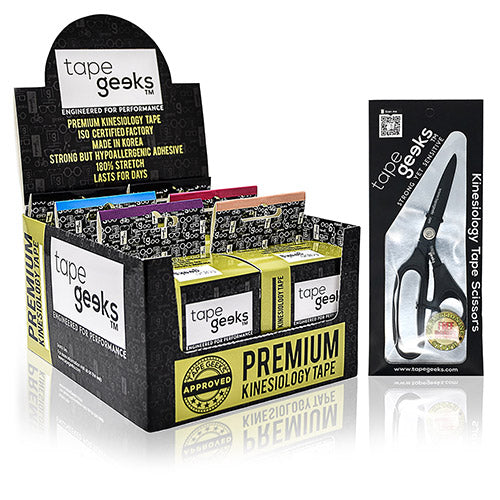
Bicipital tendinitis or biceps tendinitis is a condition characterized by inflammation of the biceps tendon. Biceps tendinitis is painful and can sometimes be disabling. Do you think that you have biceps tendonitis? Read further to know more about it.

Shop our kinesiology tape now
Shop Now
Table of Contents
A. What does bicep tendinitis feel like?
B. What are the common symptoms of biceps tendinitis?
C. What causes biceps tendinitis?
D. Is rotator cuff tendinitis similar to biceps tendinitis?
E. Biceps Tendinitis Treatment
F. Kinesiology tape for bicep tendonitis
G. Biceps tendinitis prevention
H. Conclusion
What does bicep tendinitis feel like?
The pain from biceps tendonitis is often felt when the arm is raised overhead or lifted above waist level. You might also feel a sharp pain when lifting or lowering objects that weigh more than ten pounds.
Biceps tendonitis often affects the front of the shoulder and may also cause swelling and redness in that area and a warm, burning sensation around the joint.
What are the common symptoms of biceps tendinitis?
The symptoms of Bicep tendonitis may include:
- Tenderness along the front of the upper arm near the shoulder joint
- Stiffness when trying to lift something above head level
- Visible swelling on the top middle part of the upper arm
What causes biceps tendinitis?
Biceps tendonitis is commonly caused by overusing this joint or by doing a repetitive motion without giving your muscles time to relax between contractions.
Some of the movements that cause this involve overhead motion for extended periods. It can also be brought about by an excessive force being applied to the bicep tendons causing them to become inflamed.

Some of the sports that make you prone to this injury include:
- Weightlifting
- Baseball or softball (throwing a ball overhead, repeatedly pitching)
- Swimming
- Tennis
- Volleyball
Is rotator cuff tendinitis similar to biceps tendinitis?
Rotator cuff tendinitis is another name for biceps tendinitis. They both refer to the pain and swelling on the cuff tendons and the bursa (fluid sack that helps cushion the joint).

Shop our bundles now
Shop Now
Biceps Tendinitis Treatment
If you feel like you have biceps tendonitis, we highly recommend that you visit your doctor or therapist to get a professional assessment of your condition.
The tests that the physician may conduct to confirm your condition are an X-ray, Magnetic Resonance Imaging (MRI), and ultrasound.
Some of the available treatments for biceps tendonitis may include:
- Icing the area. Using ice on the tender area will reduce swelling and decrease muscle spasms. You can use a cold pack by putting it in a bag and leaving it in the area for 10 to 15 minutes.
- Rest. Biceps tendinitis occurs when you use your arm in a way that irritates the tendon. Reducing or modifying the activities that cause biceps tendinitis can help speed the healing process and prevent further injury.
- Non-steroidal anti-inflammatory drugs. Biceps tendinitis can also be treated with over-the-counter pain relievers such as ibuprofen (Advil, Motrin IB, others), naproxen sodium (Aleve), or acetaminophen (Tylenol).
- Steroid injections.When diagnosed by a doctor, s/he will most likely prescribe a corticosteroid injection to be given directly into the area of inflammation. Corticosteroids reduce pain and swelling very quickly after injection.
- Kinesiology tape. While kinesiology tape is not a treatment per se, it can help alleviate some of the discomfort that you feel when you have biceps tendonitis. Your therapist may also include taping for the overall treatment plan.
- Surgery.If the condition does not improve with non-surgical treatments, your doctor may offer surgery. Arthroscopic surgery is usually performed for biceps tendinitis.
- Physical therapy.Biceps tendinitis can be treated with physical therapy, also known as rehabilitation. As you progress through your rehab program, the therapist will recommend certain exercises that you do at home to continue to strengthen your muscles.
Kinesiology tape for bicep tendonitis
If you’re new to kinesiology tape, you can read everything you need to know about it and its numerous benefits in our blog. We also suggest reading up on the different kinesiology taping tension guidelines before proceeding - it’ll be handy for this section!
- Measure the length of the tape you would like to use.
- Create a Y-strip with your tape. Round your edges to avoid premature peeling.
- Anchor your tape and apply 0% tension. Give the middle of the tape 15-25% tension while applying 0% tension on the ends.
- Rub in the tape to activate the adhesive.

Shop our collection now
Shop NowBiceps tendinitis prevention
As people age, they become more prone to tendonitis due to the natural wear and tear of the tendons. So, one of the best ways to prevent biceps tendinitis is to make sure that you don’t push your body too hard, especially when you’re over 30.
Here are some other things that you can do to avoid biceps tendonitis:
- Take breaks. If you want to avoid biceps tendinitis, don't lift weights or perform an activity that uses the biceps for two or more hours without stopping. If you feel pain in your bicep, take a break and drink some water. Additionally, make sure that you give your muscles time to repair after an intense workout by setting up a day or two for recovery.

- Make sure to warm up and stretch.Biceps tendinitis can happen if you don't properly warm up before an activity or stretch out the muscles after an activity. Make sure to cover all of your bases: warm up and stretch before you lift weights or do another exercise, and remember to stretch out your arms after.
- Maintain proper form.Biceps tendinitis may occur when you use poor form during an activity.
- Slowly increase your workout intensity.Biceps tendonitis can also happen if you suddenly increase the intensity of your workout. Make sure that you gradually increase your workout intensity for several weeks leading into a competition if you’re training for one.

- Don’t ignore pain. If you do experience any pain or discomfort in your bicep, stop the activity and have it checked by a doctor.
- Maintain a healthy weight. Being overweight makes you prone to tendon damage since it puts strain on your tendons.

If you already have bicipital tendonitis, avoid bicep tendon activities and strengthen your Biceps Brachii with biceps tendonitis exercises. Bicipital tendinitis prevention involves having a strong Biceps Brachii.
Conclusion
You can try kinesiology taping to alleviate the pain and discomfort associated with biceps tendinitis. If it doesn’t work, or if you want a different method of treatment, there are other options available. As always, talk to your doctor before making any decisions about what course of action is best for you.
If you’re interested in learning more about other common injuries like AC joint sprain as well as shoulder impingement, you can head over to the blog.
Thanks for reading!

Shop our accessories and more
Shop NowSubscribe to the TapeGeeks Newsletter for new videos, discounts and more!Join The Geeks Club









